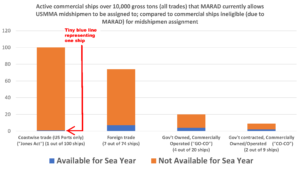MARAD is playing major games with data and semantics as part of an effort to mislead Congress and the public about Sea Year and the effect of the Sea Year pause cancellation on U.S. Merchant Marine Academy midshipmen. MARAD counts on people not being up-to-speed on how the maritime industry operates and uses carefully-worded phrases to deceive.
The topic is complex (MARAD counts on that). To counter that, I am going to do a series of posts that pull back the curtains of deception from MARAD to reveal the fake wizard behind the curtain.
The first thing to understand is what we mean when we refer to commercial sea year. We are talking about ships that are operated by the private sector with private sector manning requirements. We are not talking about government operated ships, such as government- operated Military Sealift Command ships, USCG ships or Navy ships; because, with their exaggerated crew sizes, differing missions, and major support facilities ashore, they do not approximate the real world of commercial shipping. We also are not talking about “ROS” ships—ships under contract to shipping companies to be available in time of war or national emergency but that do not otherwise engage in commercial shipping operations. These ships carry skeleton crews and rarely leave the dock.
So here’s a chart of the commercially active U.S. flag ships, broken down by type of trade. [Type of trade will be an important factor in subsequent posts on this topic.] (You can click on the charts in this post to see larger versions.)
 Prior to the Sea Year
Prior to the Sea Year pause cancellation, Academy midshipmen could (and did) sail on all of the four groups of commercial vessels described above—and in significant numbers. Now let’s take a look at how Academy midshipmen are currently being assigned to the active U.S. Flag commercial fleet (10,000 gross tons or greater):
 This is inexcusable. Out of 203 U.S. Flag, commercially operated vessels,* MARAD allows only 14 of the vessels to carry Academy midshipmen. Stay tuned for Part 2, where I will expose MARAD’s deceptive use of “SOLAS vessels” as part of its effort to hide-the-Sea-Year-ball.
This is inexcusable. Out of 203 U.S. Flag, commercially operated vessels,* MARAD allows only 14 of the vessels to carry Academy midshipmen. Stay tuned for Part 2, where I will expose MARAD’s deceptive use of “SOLAS vessels” as part of its effort to hide-the-Sea-Year-ball.
*The statistical information presented in this post is based upon current data published by MARAD, the U.S. Coast Guard, and a number of other sources. It is an incredibly cumbersome process to compile the information because the operators of many of the vessels are constantly changing and different data sets are updated at different times. Moreover, some data sets don’t track 16 Jones Act eligible ships (greater than 10,000 tons) that are in the Great Lakes trade. I’ve included the 16 “lakers” in the coastwise/Jones Act category because other than calling on Canadian ports, they cannot “go foreign” because their size prevents them from making it through the Saint Lawrence Seaway locks. Despite the uncertainty, we are confident that the numbers presented are reasonably accurate approximations.

Where is the graduate KELLY. Is he just a figure head ie a do nothing
Sen. Kelly is, now, a politician first and foremost. To make a bad pun (are there any “good” puns) the politician’s motto, no matter what party they vote with, is Verba non Acta. So, I am sure that he has a tremendous personal conflict to resolve between Loyalty to KP and Loyalty to the Democrat Party and its public and private policies. My opinion is that if Sen. Kelly hasn’t spoken up, let alone done something, on this issue since December he probably won’t.
Sen Kelly: A loyal Demo not a loyal KP grad. That’s why he hasn’t had my support since Day one
Larry Byers ’61